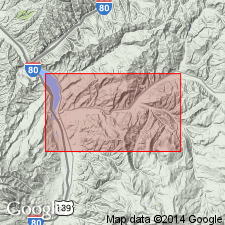
- Usage in publication:
-
- Coalville member
- Modifications:
-
- Named
- Dominant lithology:
-
- Sandstone
- Coal
- AAPG geologic province:
-
- Central Western Overthrust
Summary:
Named as a lower member (fourth of ten from the base) of the Frontier formation presumably for exposures on a ridge that strikes N35E of Coalville, Summit Co, UT on the Uinta uplift. Formerly assigned to units 11-13 by Wegemann (1913) and Cobban and Reeside (1952). No type locality designated. Overlies the newly named Chalk Creek member of the Frontier. Underlies the newly named Allan Hollow member of Frontier. Consists of marine well-bedded to massive sandstone and coal. The lower sandstone is 40 to 80 ft thick, the overlying coal is 5 to 13 ft thick, and the upper sandstone is 30 to 130 ft thick. The lower sandstone has a bivalve--INOCERAMUS LABIATUS of latest Greenhorn age. Correlated with the lower part of the marine shale member of the Frontier at Cumberland Gap, Lincoln Co, WY in the Greater Green River basin. Limits of the Coalville-Cumberland Gap nomenclature not stated. Assigned to the middle part of the Turonian, Late Cretaceous age. Cross sections. Stratigraphic chart.
Source: GNU records (USGS DDS-6; Denver GNULEX).
For more information, please contact Nancy Stamm, Geologic Names Committee Secretary.
Asterisk (*) indicates published by U.S. Geological Survey authors.
"No current usage" (†) implies that a name has been abandoned or has fallen into disuse. Former usage and, if known, replacement name given in parentheses ( ).
Slash (/) indicates name conflicts with nomenclatural guidelines (CSN, 1933; ACSN, 1961, 1970; NACSN, 1983, 2005, 2021). May be explained within brackets ([ ]).

